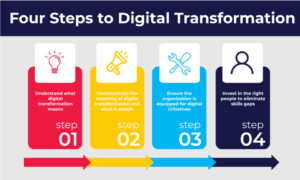Being a modern CEO is an intense balancing act. Not only do you have to keep the organization focused on and achieving objectives, but you also have to oversee strategic planning, manage staff, monitor budgets, be accountable to a board of directors and hundreds of other tasks.
With everything on your plate it’s easy to miss the biggest threat facing your company: digital transformation that is creating disruption and opportunity for you and your competitors.
Digital transformation is reshaping every sector. Innovators are entering every market with radically new product offerings that are disrupting traditional market leaders and setting new standards for ease of use, personalization, and interactivity.
The organizations that will win in this new digital world are the ones that prioritize customer value through agile, data-driven user experiences.
How can your organization harness the power of digital transformation? To create a next-generation operating model you need to follow four steps:

Step 1: Understand what digital transformation means
Digital transformation is a term often interpreted in many different ways by people at all levels of your organization. Some will believe that digital transformation is about employing the latest technology to help with business processes. Others may believe that digital transformation represents a new way of connecting with customers. So, what does digital transformation mean to you and your company?
Although you may have a good idea of what digital transformation is and how it will shape the future of the company, if others around you don’t share the same interpretation, you will slow the transformation and adoption process ultimately costing your organization revenue and market share.
As the CEO, it is your job to market the mission of digital transformation. Diverse perspectives on digital transformation reflect a lack of guidance in terms of where the business needs to go. Digital transformation is not just about experimenting with the newest technologies or connecting with customers in innovative ways, it’s about organization-wide change that is constantly evolving based on inputs from the customer. It is crucial that everyone shares the same definition of digital transformation so that priorities are aligned.
Step 2: Communicate the meaning of digital transformation and what it entails
As CEO, it is your job to communicate the meaning of digital transformation to all employees. Digital transformation is about finding new ways of connecting with customers, so everyone needs to be receptive to change and acknowledge the fact that there will be failures along the way.
You may find yourself repeating what the goal of digital transformation is and answering any related questions such as: “how will this help the organization?” “Why do we need to change the way we connect with customers?” “How long will it take to roll out all the digital initiatives?” It is the role of the CEO to encourage all employees to embrace areas they may not be familiar or uncomfortable with, such as data-driven decision making.
Larger organizations may find this step requires more time and effort to accomplish compared to smaller, more agile, organizations.
Step 3: Ensure the organization is equipped for digital initiatives
Is your organization equipped with the system and data architecture needed to carry out digital initiatives? Without a modern architecture, organizations may find it slow and costly to go from idea to implementation. It is important to maintain momentum during this time, especially if the process to acquire/build the appropriate systems and data architecture is prolonged.
Not sure if you have what you need to support a digital transformation? Engage an expert to support you in the evaluation of your tools, systems and processes.
Step 4: Invest in the right people to eliminate skills gaps
People who execute change must be equipped with the tools and knowledge needed to succeed. Investing in in-house training, such as academies, is an excellent, low-cost way of introducing employees to new ways of working that are conducive to digital transformation. After completing training programs, employees may be more susceptible to change – trying newly learned skills and approaches.
For more technical knowledge and skills, it may be necessary to hire talent externally to quickly fill any knowledge/skill gaps that prevent the organization from completing any digital initiatives.
One of the most important resource aspects to consider as CEO is a shift away from a traditional HR model. Increasingly, organizations are engaging experts on a short-term, per-project basis to fill a gap or complete a specific project. By hiring short-term, specialized skill sets you will increase your ability to find and afford top talent without being hindered by long-term budgeting and headcounts.
Conclusion
While it may be intimidating to introduce widespread change to your organization, undergoing digital transformation will ensure that your business stays competitive and relevant in an ever-changing market.
Want to know more about implementing a customized digital transformation strategy to fit the specific needs of your company? We can help.